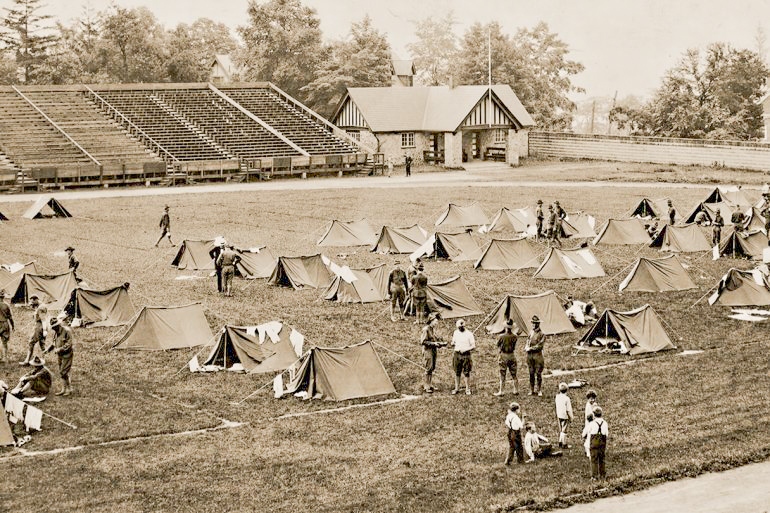How Lafayette became a military training camp during WWI
The military camp remained on Lafayette’s campus through the 1960s, leading the development of the ROTC program. (Photo courtesy of Lafayette College)
April 8, 2022
In April of 1917, the United States declared war on Germany, bringing the country into World War I. During this tumultuous time for the nation, Lafayette College was converted into a military training camp known as Camp Lafayette.
According to Director of Special Collections and College Archives Thomas Lannon, one of the reasons Lafayette took on the role as a camp is because so many of the students had already been drafted into the war, leaving few to continue their traditional education.
“Many colleges across America had developed a Student Army Training Corps (SATC) program, including Lafayette, to receive funding from the U.S government to continue their existence as educational institutions,” Lannon said.
At this time, almost 400 draftees, alongside officers, uniforms and equipment, arrived on campus and other designated areas in the Lehigh Valley. They lived in many of the dorm rooms across campus, establishing mess rooms, or places where military members socialize and eat, in the chapel and the west wing of South College and converting fraternities and the gym into barracks.
During the Spanish flu pandemic, Lafayette converted the Phi Gamma Delta and Delta Upsilon fraternity houses into hospitals. This was one place where women played a role in Lafayette’s war effort, as the college still only admitted men at the time. These women, many of whom were from the Easton area, took on jobs as nurses to aid soldiers who had been injured in training or otherwise.
At Lafayette, 579 SATC service members were inducted, including 60 members of the Navy. The vocational unit was still on campus at this time, bringing the total number of men on campus to 1,100.
“The establishment of a military camp stayed beyond World War I and even into the late 1960s. This also led to the development of the Reserved Officers Training Corps (ROTC) on many campuses across the country. Such programs enabled students to obtain a college degree whilst serving in the military,” Lannon said.
On Nov. 11, 1918, the German government signed an armistice agreement with the Allied powers. This led to the demobilization of the camp. By January, the campus reopened as a traditional college.
“The return to prosperity was represented through financial gifts that enabled scholarship, return of sport and literature,” Lannon said. Students now had the time to explore, read and develop, rather than being a solely military-focused institution.


























































































































Thomas Snyder’65 • Mar 19, 2023 at 1:29 pm
I just came across this fine article when I was searching “military science Lafayette” to find the department head.
We still had two years of required Army ROTC, when I matriculated, in 1961. Every Friday (I think it was), the campus was covered by young men in uniform, performing drills. My best friend and I spent hours spit-shining our Army-issued shoes to a high gloss.
A trumpet player, I escaped that boring activity by joining the (award-winning!) ROTC band. Upon completing the two year obligation, we were awarded the rank of E-3 (Private first class). Ahh, the memories…
Tom Snyder MD ‘65
Captain, Medical Corps, U.S. Navy, Retired